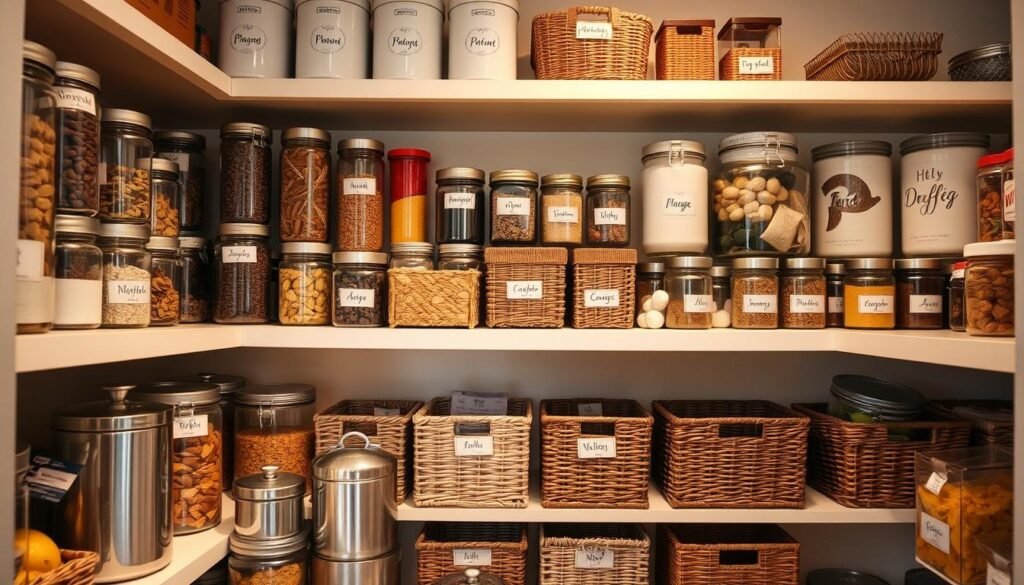
Are you tired of rummaging through a chaotic kitchen to find the ingredients you need? You’re not alone! With more people cooking at home than ever, it’s time to reassess your pantry storage and put organization advice into action.
Did you know that a disorganized pantry can lead to frustration, wasted time, and cooking inefficiency in your home kitchen? It’s a common problem that can be solved with a few simple steps.
By implementing a proper pantry organization system, you can transform your cooking experience and save you time and money. In this article, we’ll explore how to assess your current pantry situation and implement practical solutions that actually work.
Key Takeaways
- Discover how a disorganized pantry can lead to frustration and wasted money
- Learn how to implement a proper pantry organization system to transform your cooking experience
- Address common pantry challenges like duplicate purchases and expired items
- Create a functional and beautiful pantry organization system that you can maintain long-term
- Get real-world tested strategies to transform your chaotic pantry space into a model of efficiency
Why Pantry Organization Matters
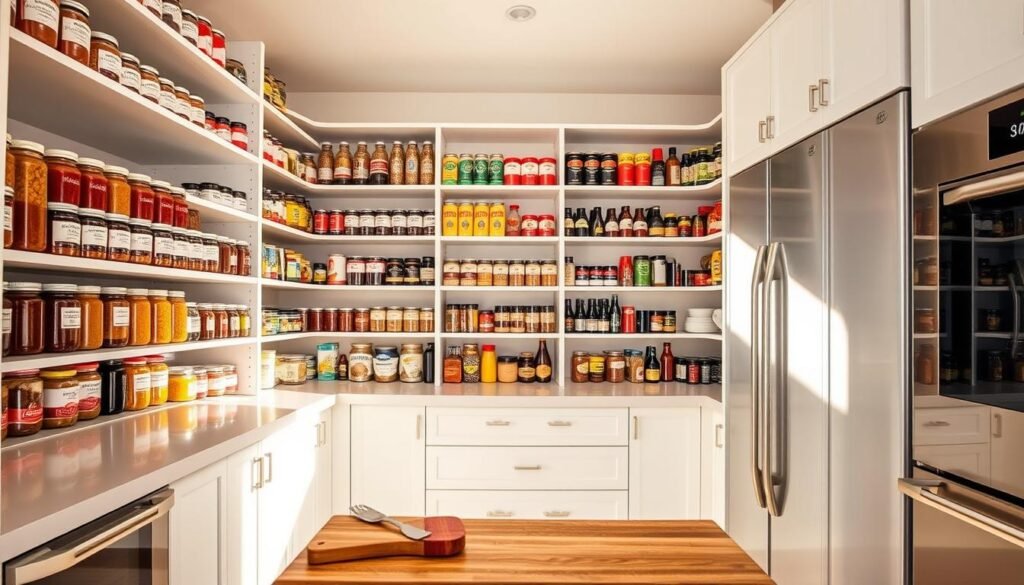
Pantry organization is not just about tidiness; it’s about creating a system that saves you time and money. When your pantry is cluttered, it can lead to a host of problems that affect not just your kitchen but your overall household efficiency.
The Hidden Costs of Pantry Clutter
A cluttered pantry can cost you in several ways. You might end up buying duplicate items because you can’t find what you already have, leading to unnecessary grocery spending. Moreover, expired food items can go unnoticed, contributing to food waste.
Benefits of an Organized Pantry Space
On the other hand, an organized pantry offers numerous benefits. It allows you to see everything at a glance, making meal planning more efficient. You’ll save time searching for ingredients and reduce mental clutter, making cooking a more enjoyable experience.
| Benefits | Impact |
|---|---|
| Reduced Grocery Waste | Saves money by avoiding duplicate purchases |
| Efficient Meal Planning | Reduces time spent deciding on meals |
| Less Mental Clutter | Makes cooking more enjoyable and less stressful |
Assessing Your Pantry Needs
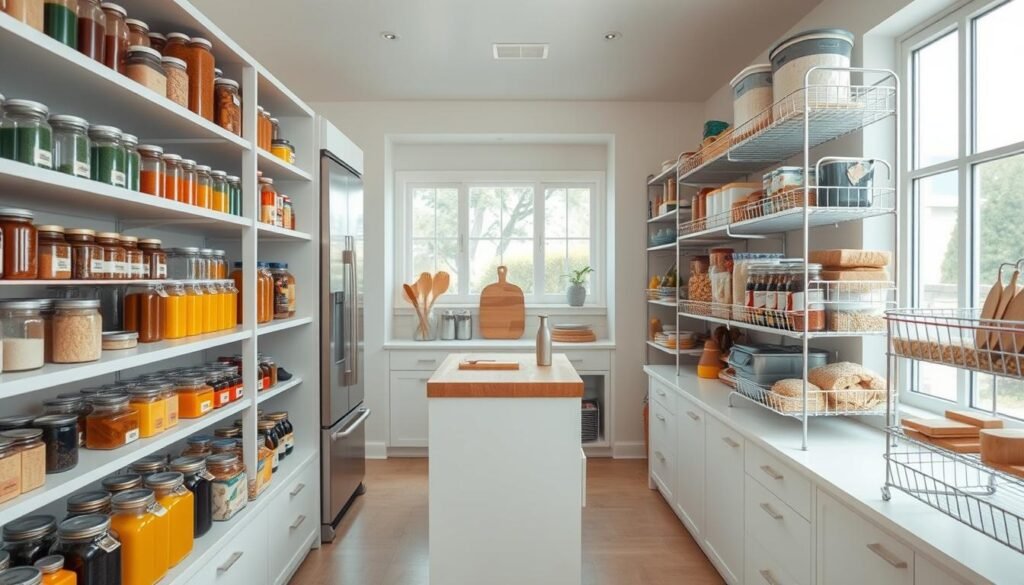
To organize your pantry effectively, you need to take stock of what you have and how you use it. This involves understanding your current space and identifying areas that need improvement.
Taking Inventory of Your Current Space
Start by measuring your shelves and noting the dimensions of your pantry storage areas. Take everything out and group similar items together to see what you have. This will help you understand what categories dominate your storage needs.
Identifying Problem Areas
Now, identify the problem areas in your kitchen pantry. Is it canned goods toppling over or spices getting lost in the back? Consider your cooking habits and the types of things you use most often. Think about the shelf space and how you can optimize it for better accessibility.
| Assessment Area | Current State | Improvement Ideas |
|---|---|---|
| Shelf Dimensions | Measured but cluttered | Use adjustable dividers |
| Item Categories | Mixed and disorganized | Group similar items together |
| Accessibility | Difficult to access back shelf | Implement a turntable or lazy Susan |
Essential Pantry Organization Supplies
Transforming your pantry into an organized oasis starts with the right supplies. To get started, you’ll need to focus on a few key categories that will make a significant impact on your pantry’s functionality.
Clear Containers and Jars
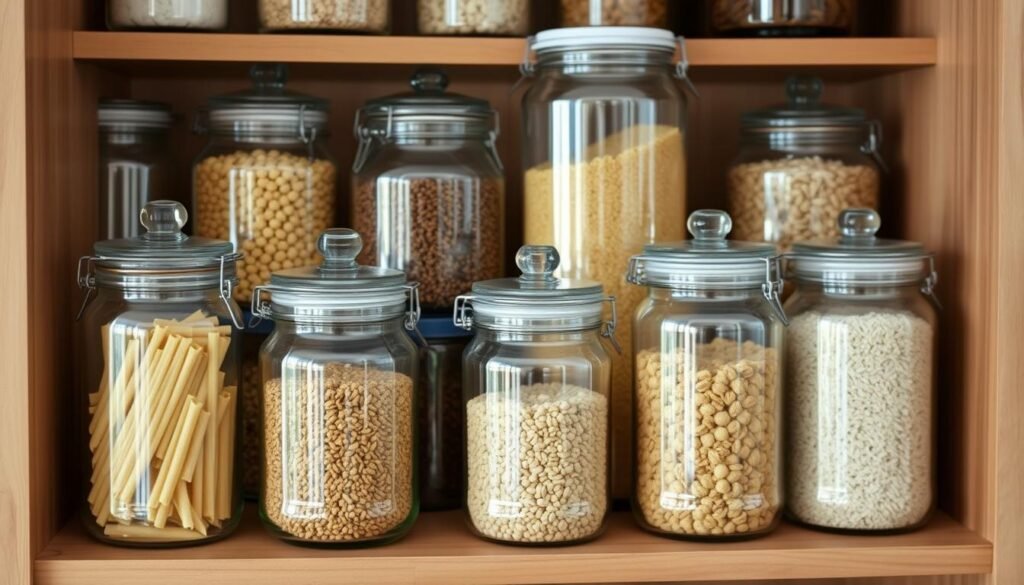
Clear containers and jars are a game-changer for pantry organization. They allow you to see exactly what’s inside and how much remains without having to open them. Airtight containers keep dry goods like flour, sugar, cereal, and pasta fresher longer while creating a uniform, stackable storage solution. You can opt for glass jars to display items or plastic containers for a lighter, more durable option.
Bins and Baskets
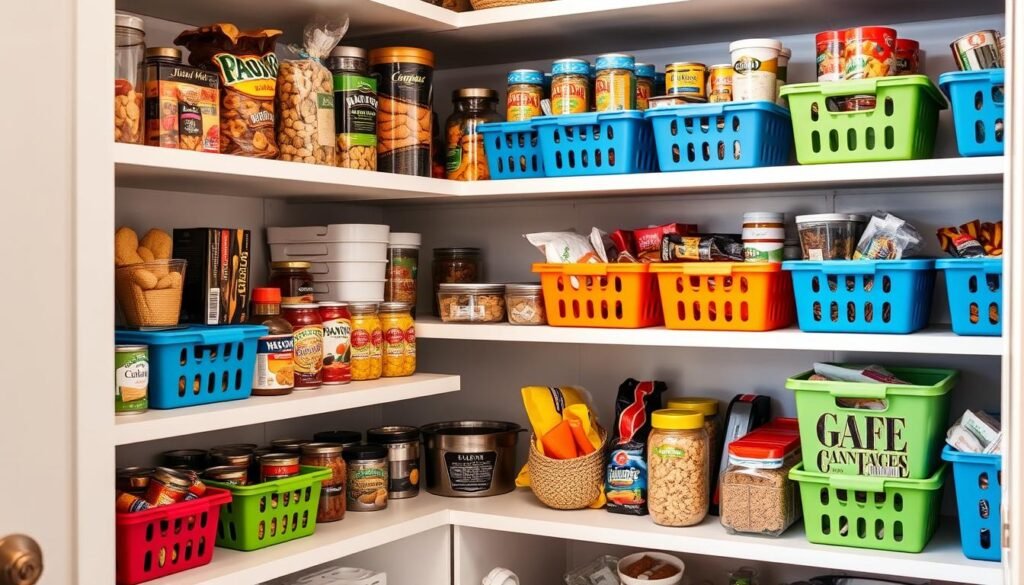
Bins and baskets are perfect for grouping similar items, preventing smaller packages from getting lost, and making categories easy to pull out and access. Consider using different colored bins or baskets for different food categories to create a visual organization system that’s easy for the whole family to maintain.
Labels and Marking Tools
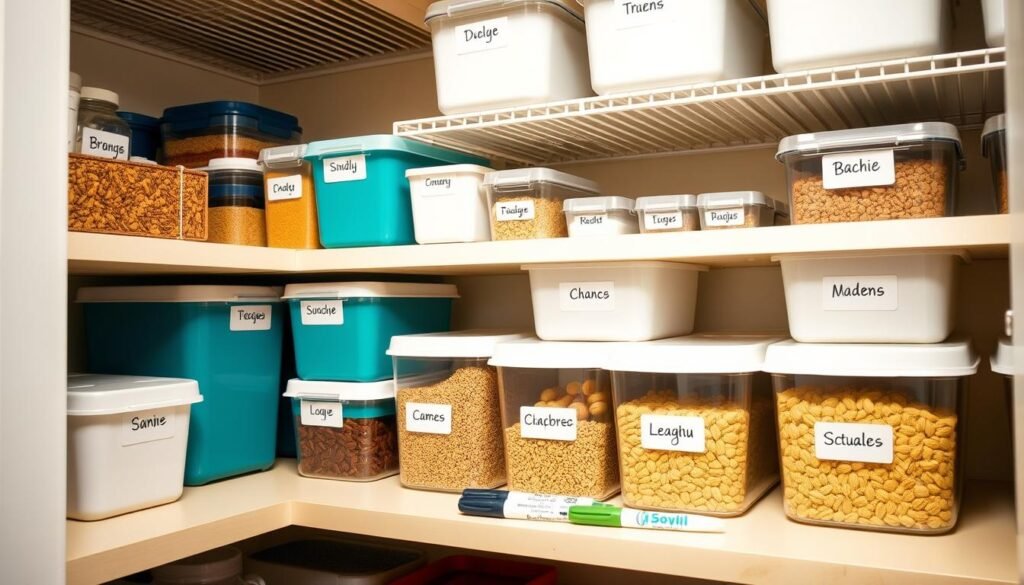
Labels are crucial for maintaining your system – they eliminate guesswork and ensure items return to their proper place after use. Marking tools like waterproof markers or a label maker help you note important information like purchase dates, expiration dates, or cooking instructions.
When selecting containers, prioritize function over aesthetics. Measure your shelves and the products you typically buy before purchasing organization supplies to ensure everything will fit properly.
Smart Pantry Organization Strategies

The key to a perfectly organized pantry lies in understanding how to optimize your storage space effectively. By implementing the right strategies, you can transform your pantry into a functional and efficient area that makes cooking and meal prep a breeze.
Zone-Based Organization
Zone-based organization involves grouping similar items, creating dedicated areas for baking supplies, breakfast items, snacks, and canned goods. This approach makes it easier to find what you need and put items back where they belong, maintaining your organization system long-term. Make sure to place frequently used items at eye level, while storing seasonal or rarely used items on higher or lower shelves.
Vertical Space Maximization
Vertical space maximization is crucial in any pantry. Use containers and shelf risers to utilize the full height of your shelves. Don’t forget the often-wasted space on the back of the pantry door, which can hold spice racks, bag organizers, or narrow shelving. By elevating just one layer of items (spices, dry goods, jars of sauce, etc.), you can create more storage space.
Accessibility Planning
Accessibility planning ensures everyone in the household can maintain the organizational system. Place heavy items on middle shelves, not on the top or floor. Consider the depth of your pantry shelves – items at the back are often forgotten, so use pull-out bins or lazy Susans to make everything accessible.
Step-by-Step Pantry Organization Process
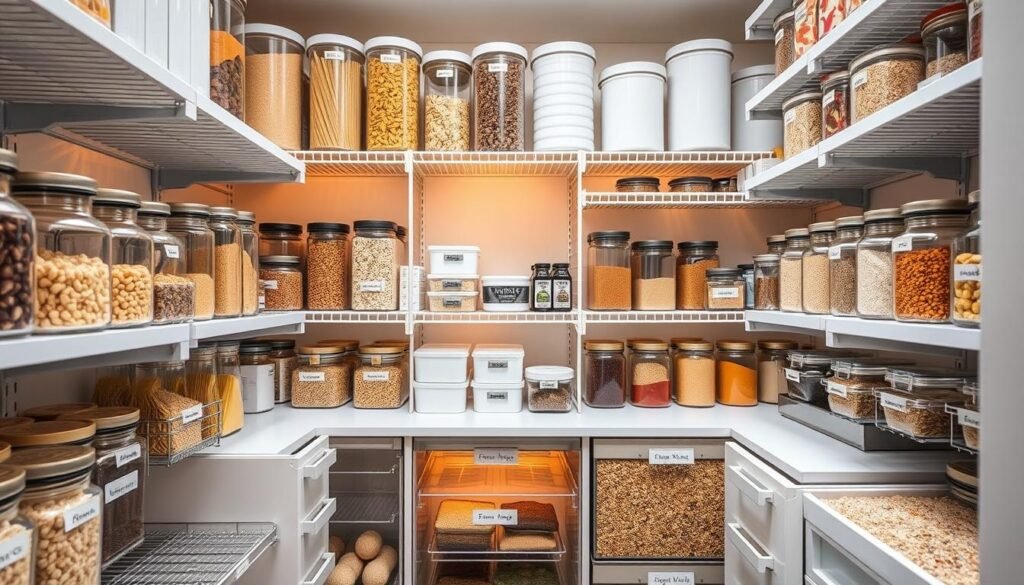
Organizing your pantry doesn’t have to be overwhelming; let’s break it down into manageable steps. By following this process, you’ll be able to create a space that is both functional and easy to maintain.
Empty and Clean Your Pantry
Start by completely emptying your pantry, removing everything from the shelves. This allows you to see what you have and gives you a chance to clean the space thoroughly. Check expiration dates and discard any expired food products. Clean all shelves, walls, and floors with an appropriate cleaner to give your pantry a fresh start.
Sort and Declutter Items
Sort remaining items into logical categories based on how you cook and eat. This might include baking supplies, breakfast foods, snacks, and canned goods. Be ruthless – if you haven’t used it in a while, it’s likely safe to get rid of it.
Group Similar Items Together
Group similar items together within these categories to see what quantities you have. This will help you determine what containers would work best for storage. For example, you might group all your pasta or your canned vegetables.
Implement Your Storage Solutions
Before implementing your storage solutions, make sure your plan accommodates all the items you’re keeping while maximizing accessibility. Start with larger containers and storage bins, then fill in with smaller items. Place frequently used items at eye level and heavier goods at waist height.
- Use clear containers to store dry goods like pasta, rice, and snacks.
- Label each container so you can easily identify what’s inside.
- Store less frequently used items on higher or lower shelves.
Clever Storage Solutions for Common Pantry Items
Transforming your pantry into a haven of organization is easier than you think with the right storage solutions. Effective pantry organization isn’t just about tidiness; it’s about creating a system that makes your daily cooking routine more efficient.
Spice Organization Systems
Spice organization systems can revolutionize your cooking experience. Consider using tiered shelves, drawer inserts, or door-mounted racks to keep your spices organized. Alphabetizing your spices or organizing them by frequency of use can make cooking more efficient. Specialized spice containers with uniform shapes not only maximize space but also create a visually appealing display.
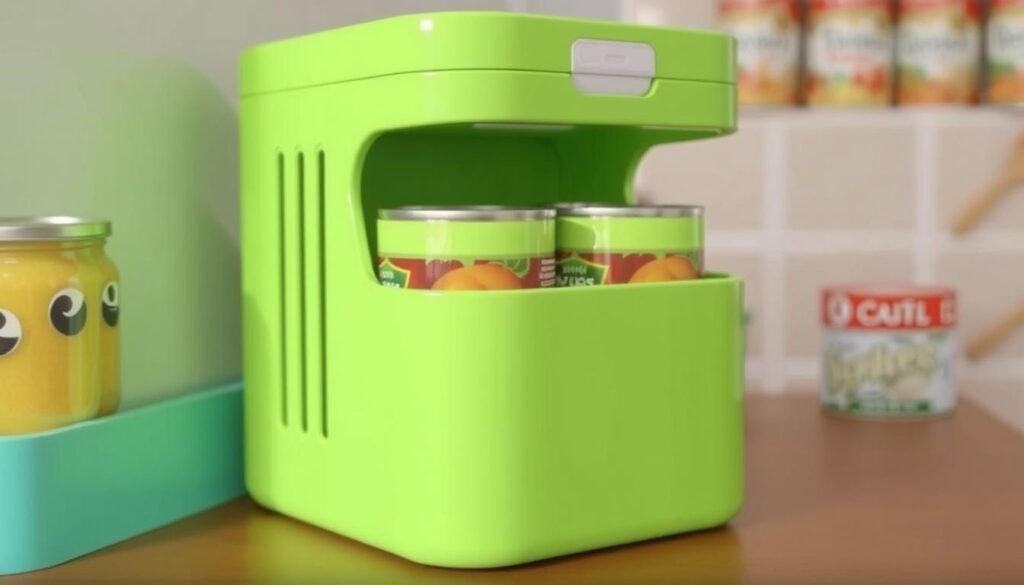
Canned Goods Storage
For canned goods, dedicated can organizers are a game-changer. They allow you to see all your options at once and automatically rotate stock, ensuring that nothing expires unnoticed. Tiered shelving for canned goods is another effective strategy, preventing items from getting lost at the back of deep pantry shelves.
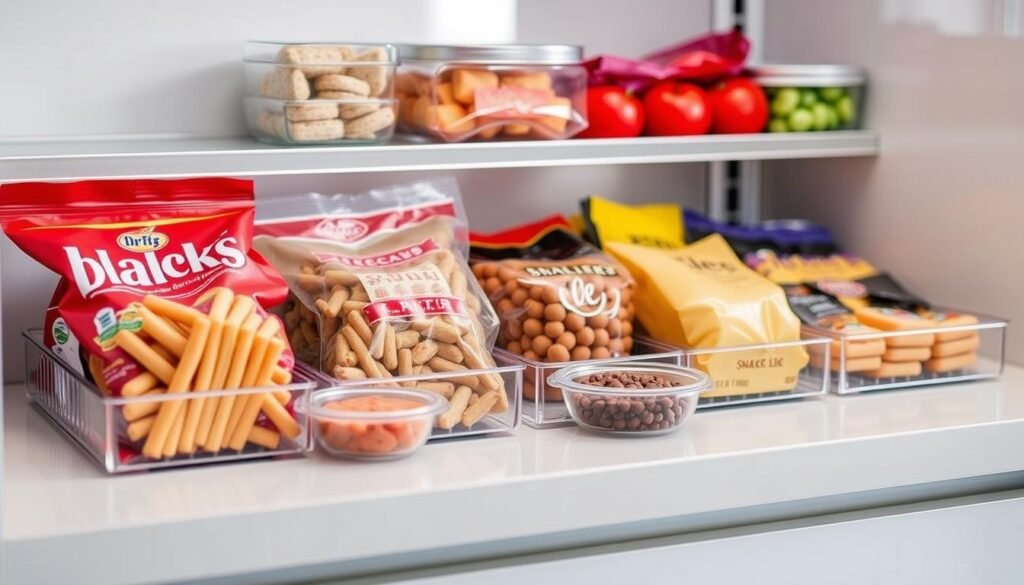
Snack and Small Item Management
For families, managing snacks and small items is crucial. Using clear containers or bins with handles can make these items easily accessible. Individual bins for different snack types help control portions and make it easy for family members to find what they’re looking for. Consider repurposing magazine holders to store bags of chips or other awkwardly shaped snack packages.
Maintaining Your Organized Pantry
An organized pantry is a great achievement, but keeping it that way requires some effort. To make sure your pantry stays organized, you’ll need to establish some consistent habits.
Weekly Maintenance Routines
Spend 5-10 minutes each week doing a quick scan and reset of any areas that have become disorganized. Before grocery shopping, take inventory of what you have to avoid buying duplicates. When unpacking groceries, place new items behind older ones to maintain proper rotation and prevent food waste. Check expiration dates regularly and move items that need to be used soon to a designated “use first” area.
Seasonal Deep-Cleaning Tips
Every 3-4 months, take everything out, wipe down all containers and bins, and reassess your organization system. Use this opportunity to donate non-expired foods your family doesn’t use to local food banks. Adjust your organization system as your family’s needs change, and label containers with the date when you filled them to track freshness.
By following these simple maintenance routines, you’ll find that keeping your pantry organized is much easier than you thought, saving you time in the long run.
Conclusion
Transforming your pantry into an organized space is a game-changer for your kitchen. By implementing a pantry organization system, you’ll make cooking and meal preparation much easier. Using containers and bins, you can keep pantry items tidy and accessible. This investment of time reduces stress and food waste, making your kitchen more efficient. Start small, be flexible, and enjoy the benefits of your newly organized kitchen pantry.
FAQ
How often should I clean out my kitchen storage space?
It’s a good idea to deep clean your kitchen storage area at least once a season to get rid of expired or unused items and keep your space fresh.
What are the best containers for storing food and kitchen supplies?
Clear containers and jars are great for storing dry goods like cereal, snacks, and spices, while plastic bins can be used for canned goods and other items. Make sure to choose containers that are airtight and easy to label.
How can I maximize my kitchen storage space?
To make the most of your kitchen storage, consider using vertical space by installing shelves or using stackable containers. You can also use baskets and bins to corral small items and keep them organized.
What’s the best way to store canned goods and other heavy items?
Store heavy items like canned goods on lower shelves or in easy-to-reach locations to avoid straining your back. Consider using a lazy Susan or a turntable to make it easy to access items in the back.
How can I keep my kitchen storage space organized over time?
To maintain your kitchen storage space, set aside time each week to tidy up and check expiration dates. You can also implement a “first in, first out” policy to ensure that older items get used before they expire.
What are some common mistakes to avoid when setting up my kitchen storage?
One common mistake is not labeling containers or shelves, making it hard to find what you need. Another mistake is not considering the size and accessibility of your storage space when choosing containers and storage solutions.
